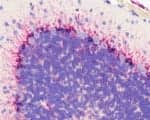
Gli1 and APOE mRNA expression in mouse brain FFPE tissue using RNAscope 2-plex chromogenic reagent kit.
Advanced Cell Diagnostics Inc (ACD), a leader in the field of molecular pathology and developer of cell and tissue-based analysis tools, is celebrating two major milestones for its RNAscope RNA in situ hybridization technology. In just three years, researchers have published more than 100 peer-reviewed papers featuring the technology. Meanwhile, the company has now built a library of more than 4,000 target probes for numerous species.
ACD’s products and services are based on its proprietary RNAscope technology, said to be the most sensitive method available for RNA in situ hybridization, and the first quantitative and fully automated platform enabling multiplex fluorescent and chromogenic RNA biomarker analysis. According to ACD, the sensitivity of the RNAscope technology enables researchers to detect single RNA molecules in situ, and provides quantitative analysis of gene expression at the single-cell level. In addition, the technology provides morphological context by showing spatial and cell-specific expression while preserving tissue architecture.
Target probes for the RNAscope system are designed to order, and can be produced in less than two weeks. Reflecting wide interest in the company’s technology, ACD says that its library of target probes has increased by more than 1,500 in just 6 months.
ACD partners with pharmaceutical and biotechnology companies to validate biomarkers for targeted therapeutic development in cancer and other diseases. These partnerships provide the foundation for ACD to develop companion diagnostics in conjunction with partners’ targeted therapeutics. ACD also pursues internal programs to develop proprietary diagnostic tests for cancer management.
Localizing and quantifying RNA sequences in the context of cells and tissues is a fundamental approach in molecular biology. RNAscope makes it accessible to researchers of any level of experience.
“Even though I had no previous experience of in situ hybridization, the RNAscope assay was easy to perform and worked first time, allowing us to confirm the expression of three different genes in the mouse eye that we had previously identified via transcriptomics,” said Alexey Pronin, PhD, of the University of Miami School of Medicine. “Importantly, the multiplex assay showed that two of the genes are expressed in two separate cell layers of the eye blood vessels—information that would be hard to get using other technologies.”
RNAscope’s ability to unlock the potential of RNA biomarkers has resulted in an average of more than 6 papers a month published so far in 2014—a rate that ACD estimates is doubling every year. Published papers involving RNAscope range from basic research in developmental biology, neuroscience, and stem cells; to clinical research such as cancer biomarkers, infectious diseases, and ophthalmology. Studies using the technology have appeared in such journals as Nature, Science, Cell, PLoS One, PNAS, and Clinical Cancer Research.
“Publications from our customers are particularly exciting, as it shows the growing validation and adoption of our technologies at the forefront of scientific research,” said Xiao-Jun Ma, PhD, ACD’s chief scientific officer. “And with our probe catalog growing by 240% in the last year, targeting more than 4,000 genes in many species, it’s a real testament to the demand for our technology, our fast probe development times, and the scalability of our platform.
“Together, these two milestones are a comprehensive validation of the effectiveness of RNAscope technology,” said Ma. “In this age of single-cell transcriptomics, RNA in situ hybridization will prove to be indispensable in the effort to characterize the many newly discovered genes—especially the vast repertoire of noncoding RNA genes. We believe that the specific benefits of RNAscope technology will undoubtedly accelerate the translation of genomic discoveries to clinical medicine, including new therapeutics and diagnostics.”
For more information, visit Advanced Cell Diagnostics.







